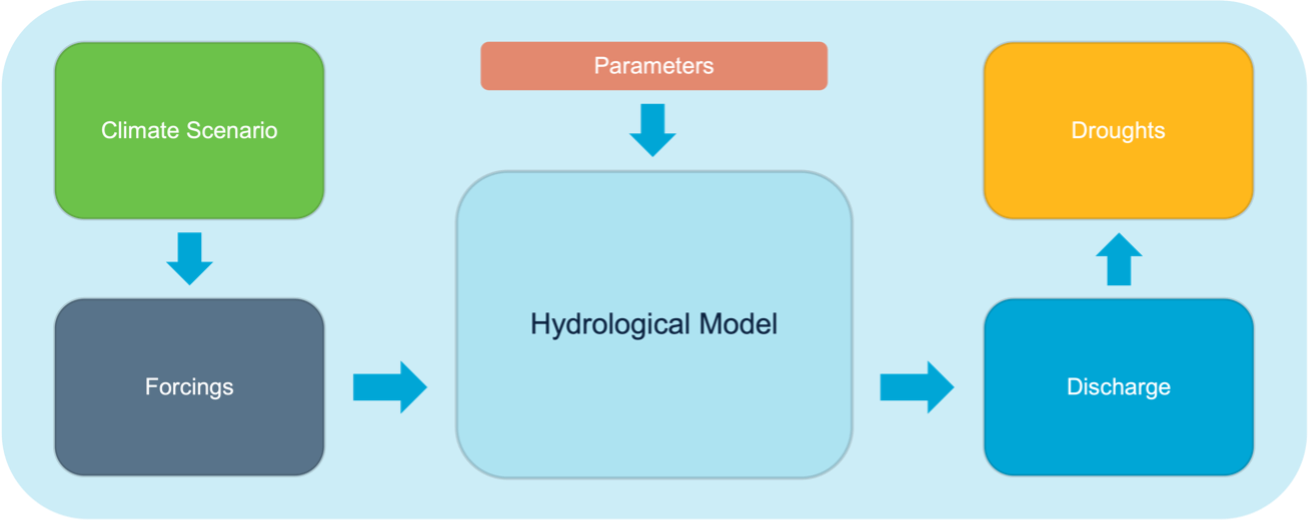Introduction#
Background#
In the summer of 2022, Europe experienced a prolonged drought, during which a lack of precipitation and a series of extreme heatwaves led to a significant water deficit in multiple river basins (Toreti et al., 2022). This was also the case for the Loire basin, where river discharge reached critically low levels, and some major tributaries dried up completely. Due to climate change, droughts have become more frequent in recent years (Vu, 2023).
Problem Analysis#
The Loire is the longest river in France, originating in the Central Massif and flowing over a thousand kilometres before reaching the Atlantic Ocean at Saint-Nazaire. It is widely utilized by the French population, with nearly half of France’s grain farming and two-thirds of its livestock farming concentrated along its banks. Additionally, the Loire serves as a crucial water source for electricity generation, supporting both hydroelectric and nuclear power production (WWF France, 2003). During droughts, these water-dependent sectors are at risk (Debein, et al., 2024). For instance, in 2016, multiple heatwaves caused a severe drought, leading to some districts losing up to 55% of their crops (Nóia Júnior et al., 2023). Furthermore, the four power plants along the riverbanks faced challenges due to the drought, as low river flow and increased water temperatures resulted in suboptimal reactor cooling (ASN, 2022). It is therefore important to research if the situation will worsen in the future.
Objective#
The objective of this research is to quantify the impact of future droughts on the hydrology of the Loire River under different climate change scenarios. This leads to the following research question: How will climate change influence future droughts on the Loire River? This question will be answered using the following sub-questions:
What are critical low water flows for the Loire basin during droughts?
How often have droughts occurred in the past?
How often will droughts occur in the future?
This research focuses on quantifying the frequency and severity of future droughts under different climate scenarios to assess the impact of climate change. The severity of a drought will be defined exclusively by its duration and water shortage. The impact of future droughts on water demand is beyond the scope of this research.
Approach#
To address these research questions, a literature study is first conducted to gain a better understanding of what causes droughts in the Loire basin and how to define them. This involves answering the first research question: “What are the critical low water flows for the Loire basin during droughts?” This critical water flow is then used to identify past droughts and predict future droughts. To generate future droughts, a hydrological model is required.
For this research, eWaterCycle is used. eWaterCycle is a hydrological modelling platform that simplifies the use of various models by allowing users to switch between them, compare them, or even use them together (Hut, 2022).
The model selected for this study will be based on availability in eWaterCycle and prior hydrological research conducted on the Loire basin. Once the appropriate model is chosen, it will be calibrated and validated using historical data to ensure its reliability before applying it to future climate scenarios. An overview of the hydrological model implementation is displayed in figure 1:
 Figure 1: An overview of the hydrological model implementation.
Figure 1: An overview of the hydrological model implementation.
The results from the future scenarios will offer quantitative insights into projected changes in river discharge and drought severity for the Loire basin.
Reading Guide#
Chapter 2 presents a literature review examining the hydrological aspects of the basin and defining a critical water flow for droughts. In Chapter 3, a historical analysis is conducted after selecting a suitable hydrological model. Chapter 4 applies this model to predict future water flow under different climate scenarios. The results are analysed in Chapter 5, followed by a discussion of the findings in Chapter 6. Finally, Chapter 7 presents the conclusion of this research.
